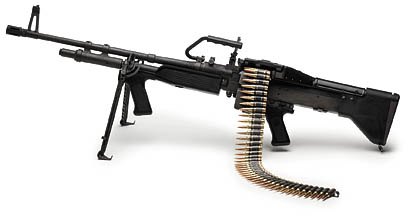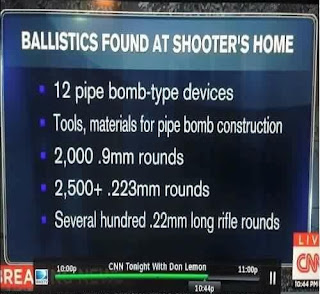This is a long series of posts because so many of my colleagues in ministry and others are making claims that seem to be cued more from politicians than actual law and facts about firearms. So first is a definition of terms, then a look at the laws regarding firearms purchases and transfers, then whether, as many of my colleagues have claimed, that we need simply to follow the UM Book of Resolutions and nothing much more.
Terms
Advocates for stricter gun control laws should at least know how to talk accurately about guns. The day after the San. B. attack,
California Democratic Rep. Loretta Sanchez claimed that multiautomatic round weapons are easily available, even though not in California.My first career was as a US Army combat-arms officer. I was qualified expert on a wide range of weapons from pistol to rifle to machine gun and anti-tank weapon. Never in my life have I heard of a "multiautomatic round weapon." All rifles and pistols fall into one, and only one, of the following categories:
1. Single shot: the gun must be manually reloaded after every shot. Single shot pistols are rare are and are mostly collector's items these days. Single shot rifles are either very specialized military sniper rifles or ordinary hunting rifles. Because they have a very slow rate of fire, they are pretty much useless for other purposes than these.
 |
| Bolt-action, single shot rifle |
The only exception I might make is the famous Winchester rifle design, which is manually reloaded from a tubular magazine, below and parallel to the barrel, by cycling a lever. Well-practiced shooters can fire these fairly rapidly, but their ammunition capacity is quite low and they are very slow to reload, so as mayhem guns they are not much suitable. That's why you never read news reports of them being used for criminal purposes.
 |
| Winchester Model 1894 |
Every magazine-fed pistol is semi-auto and in typical usage, when the media report that a criminal used a semi-auto pistol, a magazine-fed pistol is what they mean. For revolvers, some are semi-auto because those types are mechanically made ready to fire again after every shot (until ammo is exhausted). Some are not semi-auto, though, and are single shot guns because the shooter has to manually make the gun ready to shoot again after each shot. Here is the difference:
Revolvers are either Single Action or Double Action and the majority of revolvers being sold today are both. Single Action (SA) means that the shooter must manually cock the firing level to the rear for each shot. Revolvers that are Single Action Only (SAO) are therefore single-shot pistols, not semi-auto. However, Double Action revolvers do not require manually cocking the lever: load the gun, pull the trigger and it shoots. These revolvers are called Double Action Only (DAO).
The majority of revolvers are SA/DA, which means the level must be cocked for the first round, but not for subsequent rounds. These may be (I emphasize may) more useful for self defense, but the trigger control for subsequent rounds is usually not easy and they are difficult to shoot accurately in a hurry. Their real hazard is not only missing the target more often than a SAO revolver, but that to holster the gun after firing the shooter has to remember to "decock" it so it is no longer ready to fire immediately - a real safety issue.
Magazine fed pistols, such as the Walther PPK pictured below, are almost all SA/DA or DAO. In DA mode, mag-fed pistols are much easier to fire than DA revolvers because the trigger pull is doing much less mechanical work. DAO mag-fed pistols and revolvers typically do not have an exposed hammer or lever. The Walther below is a SA/DA pistol.
 |
| Colt Police Service revolver, a semi-automatic pistol |
 |
| James Bond's Walther PPK, a semi-automatic pistol |
1. Magazine fed: Most military-design rifles are magazine fed. A magazine is a container, holding various numbers of rounds, that attaches underneath the firing chamber. When the trigger is pulled, the firing assembly recoils to the rear of the chamber and the fired case is ejected. When the assembly returns forward, it strips the top round off the magazine and inserts it into the breech and the gun is ready to fire. The trigger must be pulled again to shoot one, and only one, more shot, then the whole process may be repeated until the magazine is empty. A semi-auto rifle or pistol fires one and only time per trigger pull, but the gun reloads itself after each shot.
 |
| The infamous Russian AK-47 rifle, a magazine fed rifle and the most produced rifle ever. |
 |
| WW2-era M1 Garand rifle shoring ammunition clip being inserted. |
There have been tubular-magazine, semi-auto rifles designed, but they are obsolete and no longer made these days.
3. Automatic or fully-automatic: This simply means that when the trigger is depressed, the gun will keep firing until the trigger is released or the ammunition is exhausted. Military machine guns are the best example, such as the US Army M60 machine gun illustrated below.
 |
| The M60E3 military machine gun, a belt-fed, full-automatic weapon |
It has been illegal since 1934 for private citizens to own full-automatic firearms without extensive background checks, police-department prior approval and expensive federal licensing (National Firearms Act of 1934). However, any automatic gun manufactured after 19 May, 1986, may not be owned by private citizens unless they are licensed dealers. But even they cannot transfer or sell it to anyone except police, the military or a manufacturer licensed to make automatic guns, and the dealer must surrender possession of the firearm if he gives up his license (all of which which makes the whole drill rather pointless for a dealer).
Final term for today:
"Assault rifle"
In 1993, when the Congress first moved to ban such things, I was serving in the Pentagon. I had never heard the term "assault rifle" before so I looked it up in the official DOD dictionary of military terms (yes, there is such a thing). Know what? It wasn't there.
"Assault rifle" is a political term and has no other context. What it really means is "looks scary."
So let's take a look at "assault weapons." I mean literally take a look:
Under the previous ban on assault rifles (1994-2004), this rifle meets the legal definition of an assault rifle:
And this does not:
Yet functionally they are exactly the same. Each is a .22-caliber, semiautomatic, magazine-fed rifle made by Mossberg. The top is the Model 715 and the bottom is Model 702. The barrels, bolt and magazine wells for each are identical to the other. The ammunition and effective range for both are identical. The 715 is illustrated with a 25-round magazine that also fits without modification into the 702 at bottom, like this:
What is the difference, then, between the two guns? None that affects the function:
- I guess the 715 looks scarier than the 702.
- The 715 is about $150 more (suckers!)
- The 715 has a carrying handle, but that's a matter of convenience to haul it around and has nothing to do with its lethality.
- Identical scopes may be fitted to each.
- The 715 has a "quad-rail fore-end," extending around the barrel from the breech to the front sight. Various accessories may be mounted on the rails, such as a flashlight or laser sight. This may, under some conditions, marginally improve the 715's accuracy over the 702, but not much, and has nothing to do with making the rifle itself deadlier when fired.
- The stock on the 715 is adjustable in length, but not by much. It is not a folding stock.
But what about banning "high-capacity" magazines? The 702's included magazine holds 10 rounds. Let's compute times for each gun to shoot 100 rounds. The triggers for both (being identical) can easily be pulled five times per second. Actual trigger-pulling time for each rifle to 100 rounds is therefore 20 seconds (okay, technically 19.8, but we'll round off).
It takes a shooter three seconds to swap out magazines in a hurry. To shoot 100 rounds with the 715 requires three magazine swaps, or nine seconds of changeout time. Shooting 100 rounds with the 702 requires nine changeouts, or 27 seconds, 18 seconds more.
Total shooting times:
- 715 - 29 seconds
- 702 - 47 seconds
Now, in a gunfight, 18 seconds can be a long time, but you're only getting them three seconds at a time. I don't say they don't matter, but I do say they don't matter as much as gun controllers think. The so-called "high-capacity" magazine ban is eyewash. And there are literally millions of 10-plus capacity mags already "in the wild," so to speak. What would the administration do about them?
Finally, the inefficacy of the 1994 "assault rifle" ban is well illustrated by this:
Update: A word about how ammunition is classified.
 |
| Um, no. |
Ammunition for pistols and rifles is classified according to the diameter of the bullet. It unit of measure is either in millimeters or as a decimal of an inch. For example, 9mm ammo or .45-caliber ammo. But, CNN not withstanding, they are not both at the same time, and a decimal mark never precedes the millimetric number. So there is no .9mm round nor a .22mm long rifle round.Those would be 9mm and .22, respectively.
However (because nothing should be truly simple, right?), there is a pistol round called .380 ACP caliber. (ACP simply stands for Automatic Colt Pistol). This caliber is also known as a "9mm short," having the dimensions of 9 X 17 mm. But "9mm" by itself means a round 9 X 19mm, referred to as the 9mm parabellum or 9mm Luger.
To make things even more confusing, the .380 is not actually a .38-caliber round. It and the 9mm parabellum are exactly .355 inch in diameter. So is the .357 magnum round. And both the .38 ACP and the .38 Super rounds are .356 inch in diameter. The round that actually is .357 inch in diameter is called the .38 Long Colt. Does any of this make sense? Actually, no.
Update: Reason very cogently makes the case that imprecision of language and terms infects the entire debate, but frankly only on one side. And it makes me wonder whether that's on purpose. Reason makes the same point I did, that "assault weapon" is nothing but a political term:
Contrary to what [New York Times columnist Gail] Collins et al. seem to think, the "assault weapon" category has no reality independent of legislation.Correct. See here: "Obama Wants to Ban 'Assault Weapons' but Does Not Know What They Are"
Update: When you've lost the Los Angeles Times ... . Why banning assault rifles won't reduce gun violence
The only thing unique about assault rifles is their menacing name and look.Related: "AFTER SAN BERNARDINO Support for Assault Weapons Ban Reaches 20-Year Low"
The problem starts with the term itself. The “assault weapons” for sale in the U.S. now aren't really weapons of war. ...
As a matter of functionality, these guns are just like other rifles. They're more powerful than some handguns and rifles, and less powerful than others.
... just 44 percent of Americans now support an assault weapons ban, the lowest number in the 20 years that the NYT poll has asked the question. In 2011, 63 percent of Americans supported such a ban.




